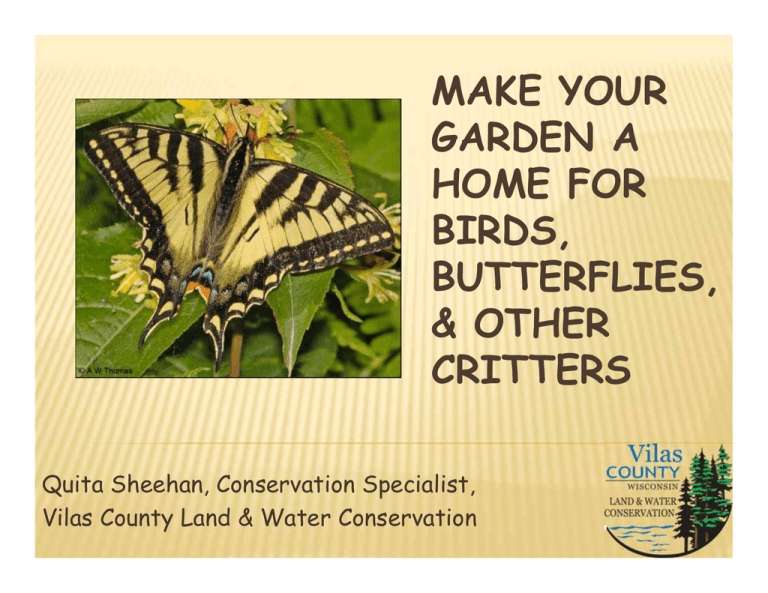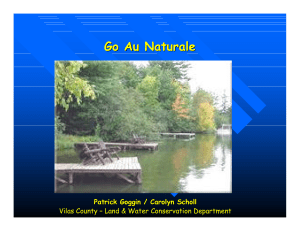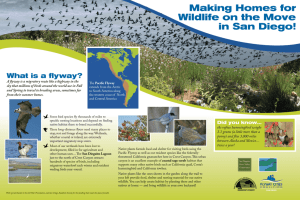MAKE YOUR GARDEN A HOME FOR BIRDS,
advertisement

MAKE YOUR GARDEN A HOME FOR BIRDS, BUTTERFLIES, & OTHER CRITTERS Quita Sheehan, Conservation Specialist, Vilas County Land & Water Conservation TALK OUTLINE Structural & plant components of wildlife habitat Design options Sources Ask questions at any time! STRUCTURAL AND PLANT COMPONENTS OF WILDLIFE HABITAT BIRD FEEDERS Provide supplemental food For best results, provide feeding areas with ‘clusters’ of 4-5 different feeders that have different kinds of foods A protective shelter of poles, brush, & grass can be built up near the feeders to enhance a potential site Maintain feeders all winter as wildlife will become dependent on your hospitality in cold snaps especially Structural component WATER FEATURES Vital component in wildlife habitat, often overlooked on uplands near lakes Attracts songbirds, mammals, small reptiles, amphibians, & insects Can be provided in many forms from a dripping source to bird baths to backyard ponds, waterfalls, to natural springs, creeks, or ponds Dripping or flowing water is more attractive to wildlife than still water Structural component DUST BEDS & GRIT Both dust & grit are used by many wild birds to satisfy special needs Bobwhite quail, pheasants, turkey, & other birds control external parasites by dusting Mourning doves are an example of a bird that uses grit for digestion Structural component SALT Salt & other trace elements are essential components of wildlife habitat Animals like deer, moose, pine grosbeaks, & crossbills will actively seek out salt Consult your local game warden or conservation officer before placing salt out Structural component CUT BANKS, CLIFFS, & CAVES Unlikely you can create them, important features to maintain if you have them on your property Sites for kingfishers, bats, bank swallows, etc. Exposed cut banks in old gravel pits used by badgers, red foxes, coyotes & woodchucks Caves vital to bats & some invertebrates Structural component BRUSH PILES, ROCK PILES, & FALLEN TREES Provide escape cover, nesting sites & den sites for cottontail rabbits, weasels, woodchucks, skunk, fox, snakes, & other species Important to reptile & amphibian habitat if placed on the edge of a small pond with part of the pile submerged Rock piles can be excellent duck & turtle loafing sites if placed out in the water Choose an unobtrusive location that offers some shelter from prevailing winds Consider nearby features such as the proximity of birdfeeders, water or other landscaping Structural component DEAD TREES (SNAGS) & PERCHES A ‘snag’ is a dead or dying tree; and to wildlife, a snag is a version of fast food 43 species of birds & at least 26 mammal species in the Midwest use snags as nesting sites, for perching sites, for territorial establishment, & as a food source A snag should be at least 6” in diameter X 15’ tall or larger Snags can be good locations to place suet feeders Consider leaving large logs on the ground Structural component STRUCTURAL AND PLANT COMPONENTS OF WILDLIFE HABITAT CONIFERS Critical escape cover Winter shelter Summer nesting sites Sap, needles, twigs, buds, and seeds eaten by wildlife Plant component GRASSES & LEGUMES Ground nesting habitat Forage for plant-eating animals Cover for ground nesting birds’ young Hunting grounds for fox, raptors, owls, coyotes, weasels and skunks Plant component PLANTS FOR BUTTERFLIES, BEES & MOTHS Attract Midwest's 200 + species of butterflies, moths, & bees Supply caterpillars need for food & nectar sources for butterflies Herbs are great for bees, moths, & butterflies Bee plants include fruit trees & shrubs, berries, daffodils, lilacs, & pussy willows Plant component HUMMINGBIRD PLANTS Ruby-throated hummingbirds common locally Flower nectar & tiny insects are the preferred diet Tubular red flowers attractive to hummingbirds Spread plants in bloom over season like columbine, bergamot, lobelias, salvia, scarlet trumpet vine, etc. Plant component SUMMER FRUIT, BERRY, & COVER PLANTS Plant a landscape with 3 layers of cover, trees, shrubs, and ground cover, which provide food and nesting cover from May through August Fruit, berry, & seed plants Shrubs that form thickets Plant component FALL FRUITS, GRAINS, & COVER PLANTS Landscape includes shrubs, grasses/grains, & cover plants ripening in fall Plant component WINTER FRUITS & COVER PLANTS Best winter wildlife plants are characterized by two qualities: persistence & low appeal to wildlife when they first mature Plant component NUT & ACORN PLANTS Hardwood trees good long term investment in wildlife production Significant food in fall & winter for whitetailed deer, turkey, ducks, squirrels, ruffed grouse, black bear, & other species Many of these species also contain natural cavities that are used by up to 96 species of wildlife Plant component LANDSCAPE DESIGN Map your property Identify your use areas Identify spots/sections to change Use models suited to your ecosystem BIRD SAFETY Protect birds from cats Protect birds from windows (place feeders <3 or >30 feet from windows) Keep feeders/bird baths clean WILDLIFE SAFETY Protect critters from cats Take in or make attractants inaccessible, especially at night Limit Chemical use PLANT SAFETY Don’t feed deer and other critters Fence or spray until plants are established Water SMALL BORDER ESTABLISHED FOR POLLINATORS PRAIRIE ESTABLISHED FOR BIRDS, INSECTS, MAMMALS AND AMPHIBIANS. Restore native vegetation on a shoreline Install or preserve a hedgerow Maintain the native habitat on your property DESIGNED BORDER Piet Oudolf designer NATIVE PLANT SPECIES USED IN FORMAL DESIGNS Piet Oudolf designed garden Bury Court England NATIVE PLANT SPECIES USED IN FORMAL DESIGNS Piet Oudolf designed park NATIVE PLANT SPECIES USED IN INFORMAL DESIGN Piet Oudolf designed landscape SOURCES Native plant species lists WI DNR - http://dnr.wi.gov/topic/WildlifeHabitat/yourland.html National Wildlife Foundation – has certification - http://www.nwf.org/ Wild Ones - http://www.wildones.org/ Noah’s Garden by Sara Stein QUESTIONS ?








